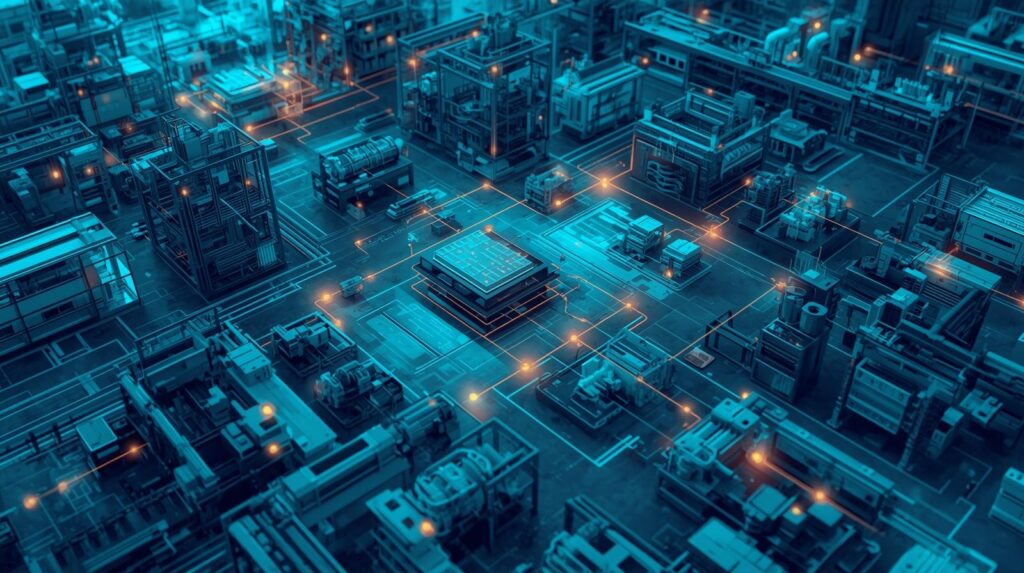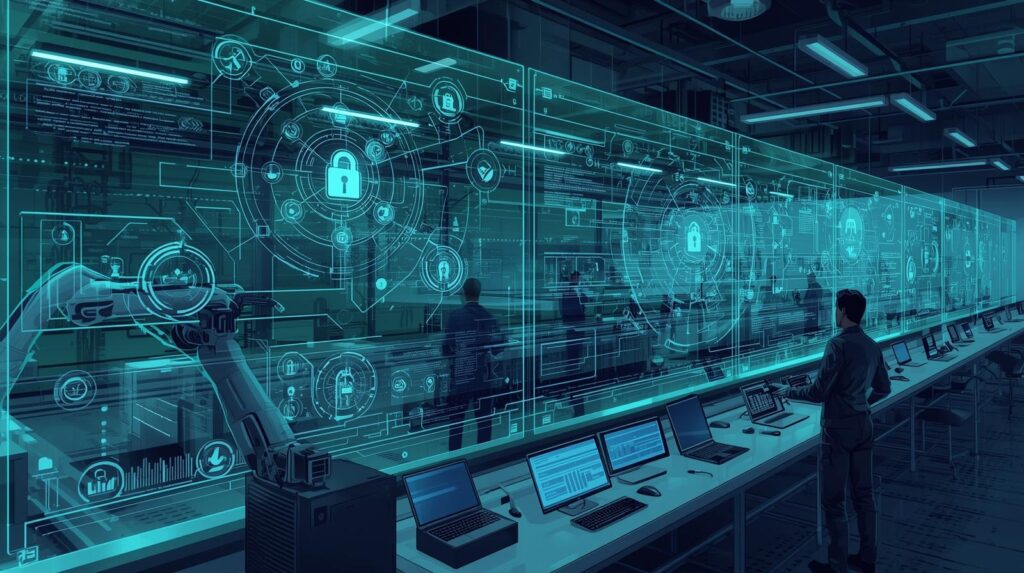The future of industrial cybersecurity in smart factories is rapidly evolving as manufacturing embraces digital transformation. Smart factories, powered by interconnected systems like the Internet of Things (IoT), artificial intelligence (AI), and automation, represent a paradigm shift in production efficiency. However, this connectivity introduces vulnerabilities that demand robust cybersecurity measures. As we look toward 2025 and beyond, understanding the future of industrial cybersecurity in smart factories becomes essential for manufacturers aiming to protect operations from sophisticated threats.

Evolution of Smart Factories
Smart factories have transitioned from concept to reality, driven by Industry 4.0 principles. The future of industrial cybersecurity in smart factories builds on this foundation, incorporating advanced technologies to enhance resilience. Digital twins, edge computing, and 5G networks are central to this evolution, enabling real-time data analysis and remote operations. Yet, these advancements amplify cybersecurity concerns, as interconnected devices become entry points for cybercriminals.
Manufacturers are increasingly adopting AI for predictive maintenance and process optimization, but the future of industrial cybersecurity in smart factories requires integrating security from the design phase. IT/OT convergence is a key trend, reshaping strategies to protect against disruptions. As factories become more autonomous, the future of industrial cybersecurity in smart factories will prioritize seamless integration of security protocols without hindering productivity.
Current Challenges in Industrial Cybersecurity
The landscape of industrial cybersecurity faces mounting pressures from evolving threats. In smart factories, legacy systems often coexist with modern IoT devices, creating weak links exploited by attackers. The future of industrial cybersecurity in smart factories must address these gaps, as breaches can lead to operational downtime, financial losses, and safety hazards.
Supply chain vulnerabilities are particularly acute, with third-party vendors introducing risks. Ransomware attacks, which have surged in manufacturing, highlight the urgency. According to industry insights, recovery costs from such incidents average millions, underscoring the need for enhanced defenses. The future of industrial cybersecurity in smart factories will involve comprehensive risk assessments, with many organizations already conducting annual maturity evaluations to identify exposures.
Talent shortages compound these challenges, as skilled cybersecurity professionals are in high demand. Manufacturers struggle to fill roles in IT, OT, and data security, leading to reliance on outsourcing. The future of industrial cybersecurity in smart factories demands investment in workforce training to build internal capabilities, ensuring teams can respond to threats effectively.
Emerging Threats in Smart Manufacturing
As smart factories advance, new threats emerge that shape the future of industrial cybersecurity in smart factories. AI-driven malware represents a significant risk, where attackers use machine learning to create adaptive code that evades detection. This trend is particularly concerning for industrial environments, where zero-day attacks could halt production lines.
Deepfakes and social engineering tactics are evolving, with cybercriminals impersonating executives to gain access. In the context of hybrid work models, insider threats amplify, as remote access to factory systems increases exposure. The future of industrial cybersecurity in smart factories must counter these by implementing behavioral analytics and continuous monitoring.
Quantum computing poses a long-term threat, potentially breaking current encryption standards. Manufacturers handling sensitive intellectual property need to prepare by adopting post-quantum cryptography. Additionally, 5G and edge computing expand the attack surface, making real-time data transmission vulnerable. The future of industrial cybersecurity in smart factories will focus on securing these technologies to prevent widespread disruptions.
The global Industrial Cybersecurity Market size accounted for USD 84.54 billion in 2024, grew to USD 93.72 billion in 2025 and is projected to reach USD 135.11 billion by 2029, representing a healthy CAGR of 9.8% between 2024 and 2029. Industrial firms, with the rising adoption of IoT and automation, are at a higher risk of cyberattacks, creating significant demand for sophisticated security systems.
Download PDF Brochure For More Info @
https://www.marketsandmarkets.com/pdfdownloadNew.asp?id=37646764
Role of AI and Machine Learning
AI and machine learning are double-edged swords in the future of industrial cybersecurity in smart factories. On one hand, they empower defenses through anomaly detection and automated threat response. Forty-nine percent of manufacturers plan to leverage AI/ML for cybersecurity by 2025, up from previous years, indicating a shift toward intelligent security systems.
These technologies enable predictive analytics, identifying vulnerabilities before exploitation. In smart factories, AI can monitor OT networks for unusual patterns, such as unauthorized access attempts. Generative AI further enhances this by simulating attack scenarios for training purposes. The future of industrial cybersecurity in smart factories will see AI integrated into security operations centers, streamlining incident response.
However, adversaries also exploit AI, creating sophisticated phishing or malware. Balancing benefits and risks is crucial. Organizations must establish governance for “shadow AI” usage, ensuring models are secure. The future of industrial cybersecurity in smart factories hinges on ethical AI deployment, fostering trust in automated systems.
Integration of IoT and Edge Computing
Industrial IoT (IIoT) is foundational to smart factories, but its proliferation demands heightened cybersecurity. The future of industrial cybersecurity in smart factories involves securing billions of connected devices, from sensors to robots. Edge computing processes data locally, reducing latency but introducing decentralized risks.
Trends show cloud-native IIoT platforms gaining traction for scalability, yet they require robust encryption. By 2025, edge intelligence will popularize, enabling real-time decisions while enhancing privacy by minimizing data transmission. The future of industrial cybersecurity in smart factories will emphasize firmware updates and identity verification at the edge.
Human-robot collaboration via AR/VR adds layers of connectivity, necessitating secure interfaces. Predictive maintenance driven by IIoT data optimizes operations but must protect against tampering. The future of industrial cybersecurity in smart factories will integrate these elements into a cohesive framework, ensuring resilience against IoT-specific threats.
Zero Trust Architecture Adoption
Zero trust models are pivotal in the future of industrial cybersecurity in smart factories. Unlike traditional perimeters, zero trust verifies every access request, regardless of origin. This approach is ideal for distributed smart factory environments, where micro-segmentation prevents lateral movement by attackers.
Implementation involves continuous authentication and context-aware policies. For manufacturing, this means securing access to critical machinery and data silos. The future of industrial cybersecurity in smart factories will see widespread adoption, countering insider threats and supply chain compromises.
Benefits include reduced breach impacts, as segmented networks limit damage. However, challenges like integration with legacy systems persist. Training teams on zero trust principles is essential. The future of industrial cybersecurity in smart factories relies on this paradigm to build inherently secure operations.
Blockchain for Secure Supply Chains
Blockchain technology offers immutable ledgers for supply chain transparency in smart factories. The future of industrial cybersecurity in smart factories may incorporate blockchain to verify transactions and prevent tampering. In manufacturing, it ensures authenticity of components, mitigating counterfeit risks.
Decentralized nature enhances resilience against single-point failures. Smart contracts automate secure agreements, reducing human error. The future of industrial cybersecurity in smart factories will explore blockchain for data integrity in IIoT ecosystems.
While promising, scalability and integration hurdles exist. Energy consumption is a concern for sustainable manufacturing. Nonetheless, blockchain’s role in the future of industrial cybersecurity in smart factories grows, supporting trust in global supply networks.
Regulatory Compliance and Standards
The future of industrial cybersecurity in smart factories involves adopting frameworks for IT/OT security. Certifications ensure interoperability while addressing vulnerabilities. As threats evolve, standards will update, incorporating AI and quantum considerations.
Training programs emphasize compliance, fostering a culture of security. The future of industrial cybersecurity in smart factories depends on proactive adherence, turning regulations into competitive advantages.
Workforce Development and Skills Gap
Addressing the skills gap is vital for the future of industrial cybersecurity in smart factories. With 48% of manufacturers facing challenges in filling operations roles, upskilling is imperative. Cybersecurity expertise ranks high, with 47% deeming it essential for hiring.
Initiatives include in-house training and partnerships with educators. The future of industrial cybersecurity in smart factories will see AI aiding workforce augmentation, but human oversight remains key. Outsourcing fills immediate needs, yet building internal talent ensures long-term security.
Diverse skill sets, blending technical and problem-solving abilities, are needed. The future of industrial cybersecurity in smart factories prioritizes continuous learning to adapt to emerging threats.
Sustainability and Green Manufacturing
Sustainability intersects with the future of industrial cybersecurity in smart factories. IIoT enables energy optimization, but secure systems prevent disruptions to green initiatives. Monitoring emissions requires protected data integrity.
The future of industrial cybersecurity in smart factories incorporates eco-friendly practices, like efficient edge computing reducing carbon footprints. Blockchain aids transparent supply chains for sustainable sourcing. Balancing security and sustainability defines forward-thinking strategies.

Digital Twins and Predictive Analytics
Digital twins simulate factory operations, optimizing processes in the future of industrial cybersecurity in smart factories. They predict threats by modeling scenarios, enhancing preparedness. Integrated with AI, they forecast maintenance needs securely.
Challenges include data privacy in virtual replicas. The future of industrial cybersecurity in smart factories leverages twins for risk mitigation, ensuring simulations remain tamper-proof.
Preparing for Quantum and Advanced Threats
Quantum computing threatens encryption, prompting the future of industrial cybersecurity in smart factories to adopt post-quantum algorithms. Stockpiled data risks decryption, necessitating forward-thinking defenses.
Advanced persistent threats demand layered security. The future of industrial cybersecurity in smart factories involves AI-assisted monitoring to counter evolving tactics.
Collaboration and Industry Partnerships
Partnerships are key in the future of industrial cybersecurity in smart factories. Collaborating with vendors ensures secure integrations. Industry consortia share threat intelligence, enhancing collective defenses.
The future of industrial cybersecurity in smart factories benefits from ecosystems fostering innovation and standards compliance.
Vision for a Secure Future
The future of industrial cybersecurity in smart factories is one of opportunity amid challenges. By embracing AI, zero trust, and IIoT securely, manufacturers can achieve resilient operations. As threats evolve, proactive strategies will define success. The future of industrial cybersecurity in smart factories promises enhanced efficiency, sustainability, and protection, paving the way for a thriving manufacturing era.
Explore In-Depth Semiconductor & Electronics Market Research
https://www.marketsandmarkets.com/semiconductorand-electonics-market-research-87.html
FAQs
What is the future of industrial cybersecurity in smart factories?
The future involves AI-driven defenses, zero trust models, and secure IoT integration to protect against evolving threats in connected manufacturing environments.
How will AI impact the future of industrial cybersecurity in smart factories?
AI will enhance threat detection and predictive analytics, but also require governance to mitigate risks from adversarial uses.
What role does IoT play in the future of industrial cybersecurity in smart factories?
IoT enables real-time operations but expands attack surfaces, necessitating edge security and firmware protections.
Why is zero trust important for the future of industrial cybersecurity in smart factories?
Zero trust verifies every access, preventing lateral movements in distributed systems common in smart manufacturing.
What are key challenges in the future of industrial cybersecurity in smart factories?
Challenges include skills gaps, legacy system integration, and supply chain vulnerabilities amid rising ransomware threats.
How can manufacturers prepare for the future of industrial cybersecurity in smart factories?
By investing in training, conducting risk assessments, and adopting emerging technologies like blockchain and digital twins.
What trends define the future of industrial cybersecurity in smart factories in 2025?
Trends include increased AI/ML usage, IT/OT convergence, and emphasis on sustainable, secure operations.
See The Latest Semiconductor Reports:
Speech and Voice Recognition Market Size, Share & Trends : https://www.marketsandmarkets.com/Market-Reports/speech-voice-recognition-market-202401714.html
Containerized Battery Energy Storage System (BESS) Market Size, Share & Trends: https://www.marketsandmarkets.com/Market-Reports/containerized-battery-energy-storage-system-bess-market-81525510.html
Building Information Modeling Market Size, Share & Trends 2030: https://www.marketsandmarkets.com/Market-Reports/building-information-modeling-market-95037387.html
Precision Aquaculture Market Size, Share & Trends: https://www.marketsandmarkets.com/Market-Reports/precision-aquaculture-market-242307580.html
Intelligent Transportation System Market Size, Share & Trends: https://www.marketsandmarkets.com/Market-Reports/intelligent-transport-systems-its-market-764.html